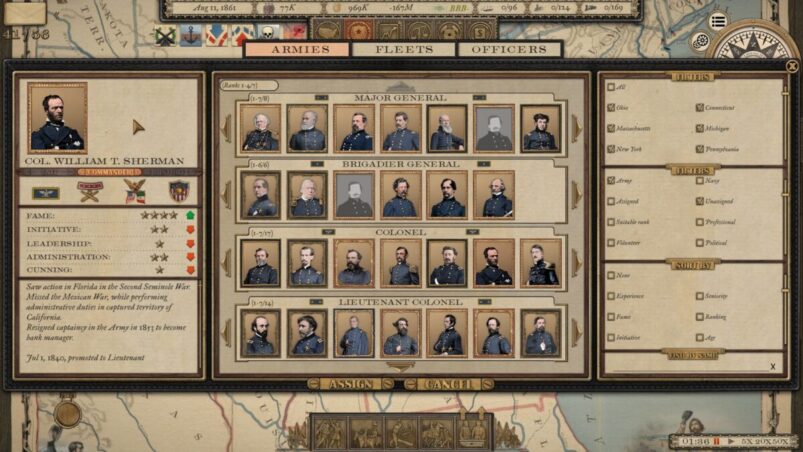The US Civil War wasn’t just about masses of men blasting away at each other with deadly fire. It was a period for interesting, compelling, and colorful personalities of various sorts to make their mark through fame and infamy and Grand Tactician: The Civil War (1861-65) captures this exceedingly well with its leadership system. As leaders are critical to an army’s success as its organization, we put together a helpful survey going over the makeup of a leader.
Here are the six main attributes in Grand Tactician:
– Traits
– Fame
– Initiative
– Leadership
– Administration
– Cunning
The leader’s overall value, quality, and experience is determined by the number of stars denoting each attribute, except traits. Generally, the more stars a leader has, the better they are in their current position.
Leaders also have ranks and if players promote leaders from a low position to a higher one, this will negatively impact the leader’s overall experience as they need time to get acquainted with their new posting.
Here’s everything you need to know about leaders in Grand Tactician: Civil War.
Traits
All leaders will have a collection of traits that can have some kind of effect on their own performance or the performance of others. These traits can range from indicating the leader’s specialty, whether they’re a veteran, whether they graduated from West Point, or if they have some effect they got during battle. Traits aren’t as impactful as the rest of the attributes, but they’re a useful starting point for determining a good role for them.
Fame
Fame is one of the more esoteric attributes for leaders as it has a smattering of limitations and effects. Leaders with high fame are great for rallying troops and give a boost to national morale, meaning support for the war will wane less per defeat and negative effect from policies and events.
The flipside is that as the war progresses, veteran units will require serving under famous generals as they want to be led by whom they see as the best personality. In addition, Grand Tactician includes a leader Feud option where characters with differing personalities may refuse commands altogether during battle due to bad relations with their fellow leaders.
On the whole, leaders with high fame benefit from higher levels of command (see our Army Organization guide) as their positive impact on national morale is quite useful and losing a high fame leader is particularly painful to the nation.
Initiative
Initiative is an important strategic attribute to have as it affects order delay, accuracy of scouting information, and army readiness when on the march. The higher the initiative stat the more responsive the army under their command will be and the more active they’ll be on the march.
On a tactical level, initiative has an effect on the leader if they’ve been set to AI behavior. Higher initiative means the unit under the leader’s command will be more aggressive in exploiting opportunities.
For these reasons, leaders with high initiative are best suited for corps and division-level command with cavalry armies in particular, benefiting greatly from a leader with good initiative.
Leadership
The leadership attribute directly affects unit morale and the leader’s ability to rally and keep the men fighting. Of the stats it’s definitely the simplest and most direct.
Leaders with high leadership can take any position, but division and brigade level command are best suited for such characters, as these formations will be doing most of the fighting.
Administration
The administration attribute dictates how well the leader is able to handle and organize logistics for their troops. This stat also allows the leader to improve the performance of their troops with training, as armies stationed in one location will begin drilling to prepare for battle, improving their fighting ability.
Administration also lets the leader’s army regain readiness on the strategic map more quickly, meaning they’ll be ready to march more quickly. All these effects are mostly related to the strategic layer and as such, leaders with a good administration attribute are best suited for army or corps-level command.
On the tactical level, administration helps with units resupplying in-battle, but this is only useful if the given battle goes on for several days.
Cunning
Cunning is probably the most balanced of the attributes being equally useful on the strategic and tactical layers. Strategically, cunning improves the scouting ability of the army, as well improves the efficiency of the army’s raiding and sieging ability.
Tactically, cunning improves the unit’s stealth making it harder for enemy scouts to spot the unit in question. All these effects make cunning an excellent attribute for a cavalry commander of a corps and brigade level to maximize both strategic and tactical benefits.
Though there’s an argument to be made that a dedicated army for sieges with artillery and engineers could benefit from a leader with high cunning, cavalry forces generally have more to gain from leaders with good cunning.
If players want their army to perform to the best of its ability, then they need to be prepared to select the right characters for the job. Now that you know how leaders affect various facets of the army, it’s up to the player to find their dream team and march on to victory.
Grand Tactician: Civil War (1861-65) is available on PC.
READ NEXT: The Beginner’s Guide To Strategy Game Subgenres
Some of the coverage you find on Cultured Vultures contains affiliate links, which provide us with small commissions based on purchases made from visiting our site. We cover gaming news, movie reviews, wrestling and much more.



